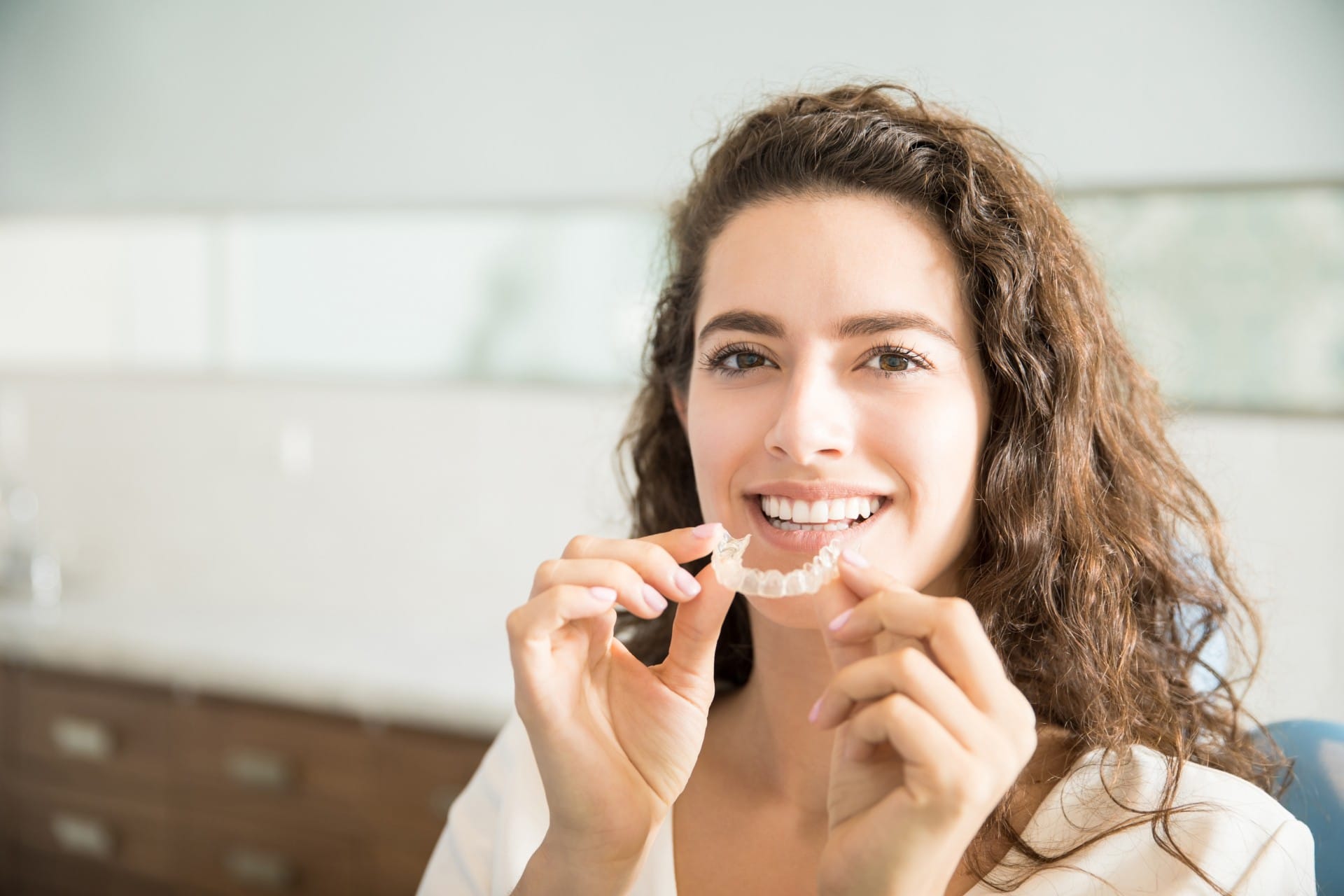VPro Accelerated Invisalign
At Caggiano Orthodontics, we are dedicated to providing our patients with the best orthodontic solutions available. We understand that as an adult, time is of the essence. That’s why we offer accelerated Invisalign treatment using Propel VPro technology.
What is Propel VPro?
Propel VPro is a state-of-the-art orthodontic device designed to enhance the efficiency of Invisalign treatment. It uses gentle vibrations known as micro-pulses to stimulate bone remodeling, allowing your teeth to move into their desired positions faster. The device is simple to use, FDA-approved, and can be used comfortably at home.
The Propel VPro device is used for just five minutes a day at a time that’s convenient for you. During this time, the device delivers micro-pulses to the jaw, stimulating cellular activity and boosting the speed of tooth movement. This means your Invisalign aligners can do their job more effectively, potentially cutting your overall treatment time in half.
Benefits of Propel VPro with Invisalign
- Faster Treatment — Propel VPro can reduce your Invisalign treatment time by up to 50%, allowing you to achieve your perfect smile sooner.
- Increased Comfort — The gentle vibrations from the Propel VPro device can help your aligners fit better and reduce discomfort associated with orthodontic treatment.
- Convenience & Ease Of Use — With just five minutes of use per day, Propel VPro easily fits into your daily routine. The device is wireless, rechargeable, and comes with a travel case, making it perfect for on-the-go use.
- Improved Oral Health — By accelerating your treatment time, Propel VPro helps reduce the risk of oral health issues associated with prolonged orthodontic treatment.
At Caggiano Orthodontics, we are committed to providing our patients with the best and most efficient treatment options. With Propel VPro, we can offer you a faster and more comfortable path to your perfect smile. If you’re an adult considering Invisalign treatment, contact us today to learn more about how Propel VPro can enhance your orthodontic journey.

Phase 1 Early Treatment
The American Association of Orthodontists recommends all children have an orthodontic screening around age seven. Usually, the first permanent molars and permanent incisors have come in by that time. Orthodontic treatment and braces are not usually started at this age unless severe problems exist that will adversely affect the way the teeth are growing. Also, an upper and lower jaw that is growing too much or not enough can be recognized at this age. If children are found to have this jaw discrepancy, it is best to treat it sooner rather than later.
Some common problems that benefit from early treatment include:
- An anterior crossbite (One or more of the upper front teeth are behind the lower front teeth upon biting.)
- A posterior crossbite (One or more of the upper back teeth are inside the lower back teeth. This can cause a shift of the jaw upon closure.)
- Severe crowding
- Crooked teeth cause psychological stress
- The midlines of the upper and lower teeth don’t line up (Potentially indicates other problems)
- Upper or lower front teeth protrude excessively
- Thumb-sucking or finger-sucking habits
- Unusually early loss of a baby tooth, allowing the adjacent permanent teeth to shift
Early (phase I) treatment is only recommended in about 5-10% of the patients we evaluate. In most cases, growth and development are seen as normal and no intervention is required.
What Is Early Treatment (Phase 1)?
The major advantage of a two-phase treatment is to allow the permanent teeth to erupt into their best natural position and restore the normal developmental relationships of the teeth. The eruption of each tooth is affected by those around it, so proper positioning of the teeth during early development serves as the foundation for normal growth. In such cases that possess the problems listed above, treating them early can help avoid the development of more serious dental problems over time. Many of these orthodontic problems can be treated much more easily by working with the growth that takes place in younger children. Early treatment (Phase 1) often reduces the difficulty of comprehensive treatment (Phase 2) and helps make optimal treatment outcomes more achievable.
Other Benefits of Early (Phase 1) Treatment Are:
- Improve the airway (reduce snoring, sleep apnea, and ADHD-like symptoms)
- Adjust the width of upper and lower dental arches
- Make space for permanent teeth (avoiding the need for extractions later)
- Relate the upper and lower jaws to each other properly
- Reduce the likelihood of impacted permanent teeth
- Eliminate shifting of the jaw on closure
In other words, early treatment can simplify later treatment! Early treatment provides a good foundation for a smile that will last a lifetime.
What If I Don’t Do Early (Phase 1) Treatment?
The disadvantage of not doing Phase 1 when recommended is facing the possibility of a compromised result that may not be stable. The longer some problems go unrecognized, the harder they are to treat. Many of these orthodontic problems can be treated much more easily by working with the growth that takes place in younger children. Some developmental problems, like functional shifts of the jaw, open bite tendencies, and under-bites, actually have a strong negative impact on facial growth. Early intervention for these developmental problems can have a significant impact on your child’s facial development and appearance. Other disadvantages of waiting for complete eruption of permanent teeth and having only one phase of treatment are:
- Possible gum loss or visible enamel wear and notching of the teeth
- Asymmetric jaw growth
- Impaction of a permanent tooth or asymmetric eruption and tooth alignment
- Extractions may be necessary
- Only a compromised orthodontic result may be achievable
- Extractions and/or oral surgery may be required to obtain a proper occlusion
- Longer treatment time in braces
How Does This Fit With The Two-Phase Treatment Approach?
Two-phase orthodontic treatment consists of:
- Early (Phase 1) Treatment — Usually between the ages of 7 and 10
- A Maintenance Phase
- Phase 2 Treatment — Initiated once most of the baby teeth have fallen out
The American Association of Orthodontists recommends all children have an orthodontic screening around age 7. Usually, the first permanent molars and permanent incisors have come in by that time. Orthodontic treatment and braces are not usually started at this age unless severe problems exist that will adversely affect the way the teeth are growing. Also, an upper and lower jaw that is growing too much or not enough can be recognized at this age. If children are found to have this jaw discrepancy, it is best to treat it sooner rather than later.
What Is The Maintenance Phase?
A successful first phase improves the appearance of the teeth and creates an unobstructed path for all of the teeth to erupt into the mouth. A normal developmental relationship is achieved, and usually, only some of the permanent teeth have grown into position. In other words, some baby teeth may still need to fall out, and it is necessary to wait until all of the permanent teeth have erupted into position before the bite and final alignment of the teeth can be evaluated. This is called the maintenance phase.
Retainers are sometimes recommended to preserve the relationship achieved during the first phase of treatment, but these are then discontinued to allow the loss of the baby teeth and eruption of the permanent teeth. It is best to allow the existing permanent teeth some freedom of movement while the final eruption of the permanent teeth occurs. In some instances, Phase 2 may not be necessary if all the permanent teeth erupt properly. During the maintenance phase, periodic recall appointments are required to monitor the growth and the eruption of the permanent teeth.
What Is The Second Phase Of Treatment?
The final alignment of the teeth and bite correction are the goals of the second phase of treatment. We strive to create harmony between the lips, cheeks, tongue, and other teeth.
Bite correction is important for several reasons:
- Ideal positioning of the bite helps prevent accelerated tooth wear from functional interferences;
- Ideal positioning of the bite helps maintain a healthy TMJ (jaw) joint;
- Ideal positioning of your teeth and bite means you will have a more stable result.
What does this mean for your child? The teeth are more likely to remain healthy and straight throughout life if you properly correct the way the teeth fit together and function.

Airway Orthodontics
Our Expert Orthodontist Can Help You Breathe Better
Airway orthodontics specialists are trained to diagnose and treat breathing disorders associated with certain orthodontic abnormalities. Orthodontic treatment is about more than aesthetics; proper alignment of the teeth and facial structure is essential for free breathing and overall physical health. Our expert for airway orthodontics in Parsippany, NJ, is pleased to tell you more about how these treatments can help you breathe easier.
Why Arway Orthodontics?
Airway Orthodontics focuses on the relationship between orthodontic health and breathing. The goal is to treat malocclusion and correct facial abnormalities to restore normal, healthy breathing for life. Facial structure and jaw abnormalities can lead to limited airflow and airway collapse during sleep, known as obstructive sleep apnea. Abnormal breathing and obstructive sleep apnea can reduce oxygen levels, interfere with normal physical and behavioral development in children, and cause serious health problems if left untreated.
Effects & Symptoms of Obstructed Breathing
Obstructive sleep apnea can put you at higher risk for physical health problems, including heart disease, high blood pressure, and stroke. It is important to be evaluated by our airway orthodontics specialist if you or your child experience any of the below symptoms. Both physical and behavioral symptoms can manifest, such as:
- Breath-holding or periods of no breathing during sleep
- Snoring
- Teeth grinding
- Shallow breathing
- Bedwetting
- Chronic tiredness or lethargy
- Hyperactivity or restlessness
- ADHD
- Nightmares
- Mouth breathing
Causes & Treatments
Some common causes of obstructed breathing that are tied to facial and jaw abnormalities include:
- Abnormal breathing patterns, rapid breathing, and improper tongue placement
- Improper development of the mandible, maxilla, or other jaw components, leading to limited airflow
- Genetic factors that have changed the size and/or shape of the face
- Our orthodontist will ask about your symptoms, examine the structure of your face and jaw, and determine if there are airway problems.
We will then recommend a customized treatment plan, depending on your specific case and symptoms, to restore normal airway function. We will also address any other orthodontic concerns you may have.
If you notice any symptoms that point to breathing obstruction, such as snoring or periods of stopped breathing during sleep, or you are otherwise concerned about you or your child’s orthodontic health, please request a consultation. It is important to address these symptoms as soon as possible to prevent serious health problems. We are here to help you or your child enjoy a lifetime of healthy breathing!

Retainers
When you’ve completed the moving part of your orthodontic treatment, you’re ready for the holding part. The next few months are the most critical part of your orthodontic treatment! Your retainer is designed to hold your teeth in their corrected position until the bone surrounding the roots of the teeth “fills in” and makes them “solid.” If we do not retain (or hold) the teeth following orthodontic tooth movement, the teeth will move back toward their old positions, and all that time wearing braces could be wasted.
If your retainer is going to do the job, here are the things you must do:
- Wear your retainers as instructed by Dr. Caggiano. This is usually all the time for the first month, followed by nighttime for a lifetime.
- During the first month, take your retainers out only when eating…and always put retainers in their case! Most retainers are lost in school lunch rooms or restaurants. NEVER wrap the retainer in a napkin or tissue, as they may be thrown away. If you put them in your pocket, they will break when you sit down.
- Keep your retainers away from your pets — they love to chew on them.
- Clean retainers thoroughly once a day with a toothbrush and warm water (no toothpaste — it can scratch the retainers). Use warm but not hot water. Brushing retainers removes the plaque and eliminates odors. Efferdent or other orthodontic appliance cleaners can be used, but they do not take the place of brushing.
- Initially, you may find it difficult to speak. Practice speaking, reading, or singing out loud to get used to them faster. In 2 or 3 days, your speech will return to normal.
- Retainers are breakable, so treat them with care. If retainers are lost or broken, call our office immediately.
- If you have any questions or concerns about your retainers, or if your retainers need adjusting, call us. Do not try to adjust them yourself.
- Always bring your retainers to your appointments.
- Keep retainers away from hot water, hot car dashboards, pockets, the washing machine, and napkins.
- Retainer replacement is costly…but with proper care, they will last for years!
- Even after braces, you will still need appointments. You will have fewer office visits, but checking your retainer is still very important.
- Always remember to bring your retainer to every appointment. If you lose or break a retainer, please call us immediately.
Congratulations on making it to this phase of your treatment journey! Remember, if you have any questions or problems with your retainer, our team is still here for you even once the tooth-moving stage is complete.